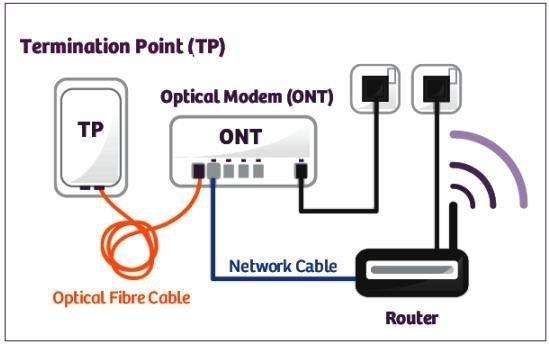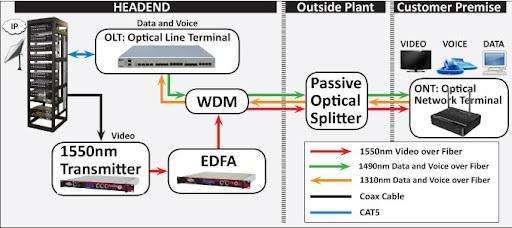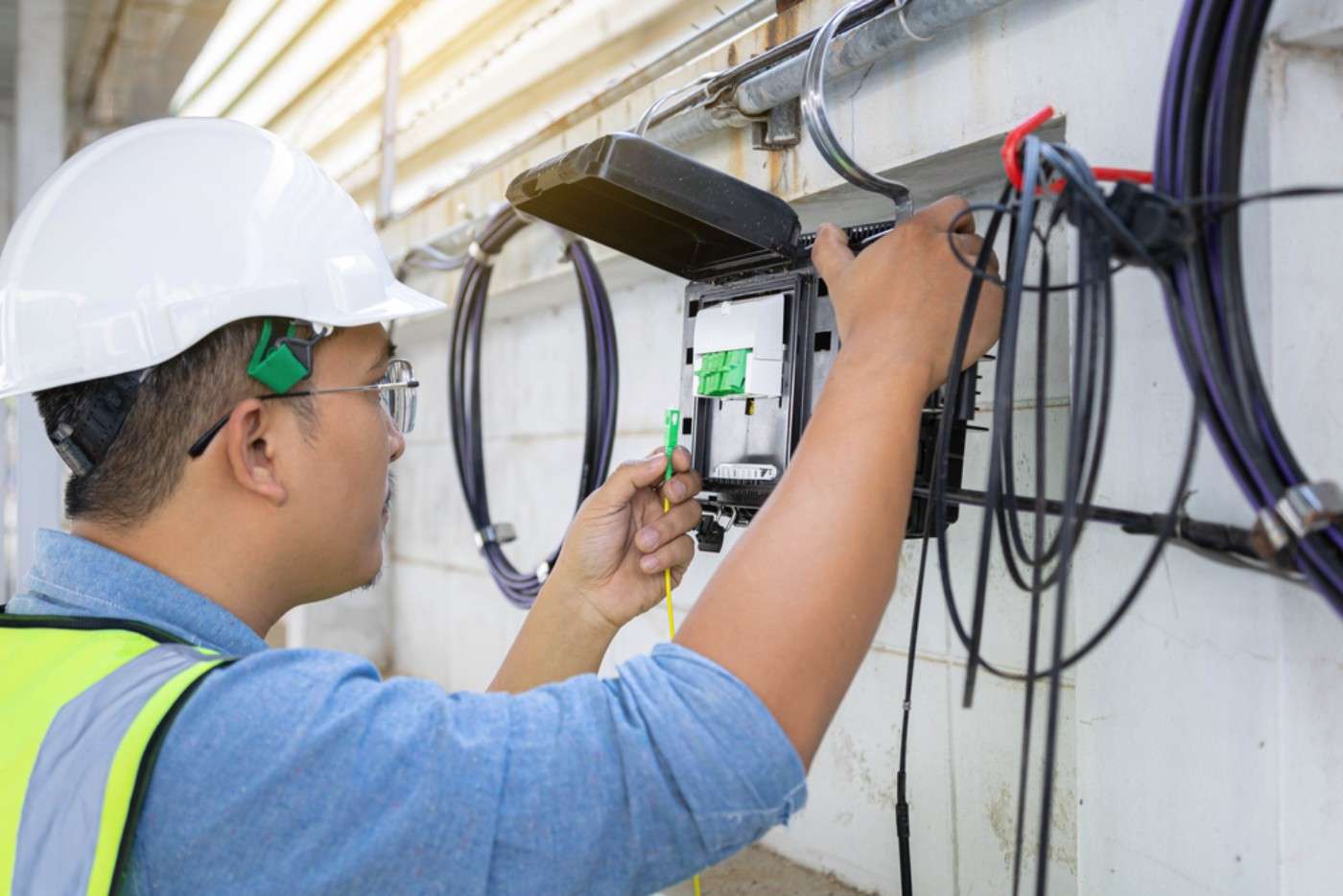
Optical fibers are the information superhighways of the modern world. And to use it better, it helps to get familiar with some, if not all, of the individual technology components it comes with. In this blog, we’ll explore Optical Network Terminal (ONT) — what it is, its purpose, and how it works.
Contents
What is an ONT & what is its role in fiber networks?
ONT is an interface between the Internet Service Provider (ISP) and the end user of fiber Internet. It’s an integral part of the fiber optic internet system because it converts optical signals into information your computing devices can digest. In other words, it works as a modem if you get your broadband Internet through Fiber to the Premises (FTTP).
Most of the time, homes and offices already have coax cables installed. In that case, a cable modem and router are the best fit. Otherwise, you must install expensive fiber cabling, ONT, and fiber routers to access an optical fiber internet connection.
ONT requires electrical power to operate and plugs directly into any existing AC electrical outlet in your facility. It converts incoming high-speed optical signals into electrical signals that your TV, telephone, and internet can comprehend.

What is the purpose of an ONT?
You cannot use a traditional coax cable modem or router if your ISP provides fiber-optic internet. You must have an ONT device and fiber router if you have fiber installed in your home or office premises.
Without ONT, your smart devices won’t know how to interpret the super-fast incoming light signals. Also, your devices cannot convert any incoming information, which is in the form of an electrical signal, back into optical signals for them to gracefully travel the vast fiber optic network at large.
ONT is a device that connects with an ISP directly and brings a high-speed fiber-optic internet connection to your doorstep, be it your home or office.
Precautions while installing ONT at user premises
ONTs are usually made up of a tamper-proof plastic box that guards all the electronics and connections against sun and rain. Only authorized personnel have access to inner compartments within the ONT.
The end user’s main supply powers the ONT and is housed on your facility’s outer wall. Lightning can damage ONT, so precautions must be taken to save customer equipment from potential transient damage.
Often, an ONT may have a locate wire or a metallic strength member grounded within the ground lug. It’s either left floating inside the ONT or snapped off and taped safely.
Users may complain about RF interference if ONT is not grounded correctly. Although analog broadcasts are rare these days, interference from radio signals can still mess with ONT signals. Moreover, if the ONT is not correctly grounded and a fire breaks out at the facility, the ISP may get exposed to legal litigation and settlements.
How an ONT works?
ONT is a fiber-optic modem that communicates with your ISP using infrared light rays. First, you get access to an internet connection through the ONT device. After that, the directly connected fiber router broadcasts the Wi-Fi signal across your facility.
Although the process seems similar to a coax Wi-Fi ethernet network, the cabling differs.

With the help of optical fiber, ONT connects to the Terminal Point (TP). A Terminal Point is a wall-mounted box where the optical fiber terminates in your home or office. The builder installs the TP during the building construction phase.
The ONT connects to your router through a LAN or Ethernet cable. It converts optical signals from your ISP into electrical signals that your router can ingest and put to good use.
What is the difference between ONT and OLT?
While setting up fiber Internet at your place of choice, you may come across an exhaustive list of abbreviations such as ONT, OLT, PON, ONU, and more. However, for simplicity, trying to understand all of them at once may get daunting. So first, let’s know the difference between ONT and OLT that helps gauge your ISP’s services better.

- Optical Line Terminal (OLT) serves as your ISP’s endpoint. The device is installed at your ISP’s hub. It provides an interface between Passive Optical Network (PON) and your service provider’s primary network.
- But, an ONT forms the endpoint of the PON at your end. It is the user-side equipment that is installed in your home or office.
Although the fiber Internet network is blazingly fast and secure, it can get expensive due to the installation of devices such as an ONT and fiber routers. It is best to consult with your ISP and identify the best offering that meets your personal or business goals.
FAQs
1. What does the Optical Network Terminal do?
The ONT converts light fiber network signals into copper and electric (Ethernet wiring) for use by your router.
Light enters the eyes, hits the retina, and the retina converts that light into electrical signals that the brain can understand and interpret. An optical network terminal (or ONT) performs a similar function to the retina in that it converts fiber signals (basically light) into information that your devices can understand.
An Optical Network Terminal (ONT) is typically found on the outside of your home or in your garage, and it is critical in bringing fiber Internet to your home via your internet service provider.
2. Is Optical Network Terminal a router?
No, it functions as a modem and connects to a fiber router to provide optical Wi-Fi service. A router is a device that forwards data packets to the correct person (specific IP address/Mac address) on the network, similar to how a mailman knows the addresses of all the houses and drops the correct mail at the correct location.
An ONT (optical network terminal) is similar to an ONR (optical network router) except that it lacks router functionality. The ONT converts light fiber network signals into copper and electric (Ethernet wiring) for use by your router.
3. Is ONT cable the same as Ethernet?
The ONT – Optical Network Terminal (also known as the modem) is connected to the Termination Point (TP) via an optical fiber cable. Using an Ethernet cable, it connects to your router and converts light signals from your TP’s fiber optic line into electronic signals that your router can understand.
Ethernet, on the other hand, is a local area network access technology. So, any cable that allows connection with a system/device within a LAN can be referred to as an “ethernet cable” or “network cable.” There appears to be no distinction between network and Ethernet cables. Ethernet and LAN cables are types of network cables.
4. Can you plug the router directly into ONT?
The answer is that you can connect your router to the ONT, but not directly. Your router will be connected to either an Ethernet port on the ONT or an Ethernet jack on the wall. You can connect devices via Ethernet cables, or the router will broadcast WiFi.
ONT is a fiber Internet modem that is installed in one of several locations depending on the type of home or property. Before installing the ONT, the Internet service provider checks and evaluates every detail. Because of differences in ONT installation locations, the process of connecting your router to it varies. You cannot simply plug your router into ONT using a standard procedure.
5. Is ONT the same as the modem?
The term “modem” is generally reserved for devices that encode digital data onto an “analog” medium. A modem is typically used when a digital signal is modulated with frequency to encode multiple bits per symbol/signal.
An ONT contains a modem, and an ONT for a PON deployment may include a modem of some kind.
So, no, an ONT is not a modem because fiber has no carrier wave.
The term “modem” is an abbreviation for MOdulator/DEModulator, and it refers to three types of devices: telephone modems, DSL modems, and cable modems (thx, Cody). An ONT is an Optical Network Terminator that connects your LAN to the ISP’s (passive) optical network.













